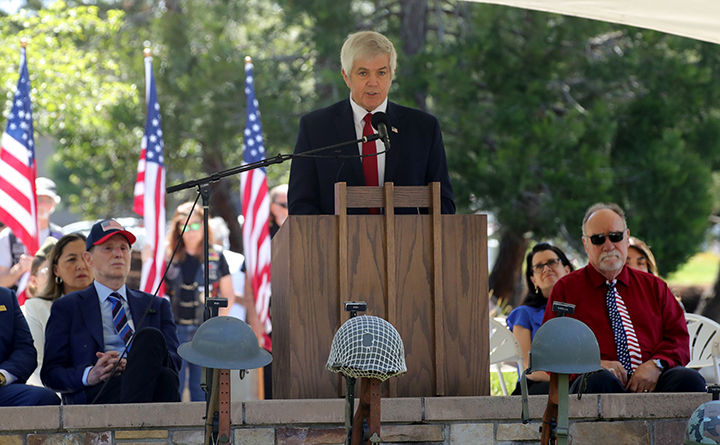Scientists predict above average temps, below average precipitation this winter
Published 5:00 pm Wednesday, October 2, 2002
The same climatic phenomenon that is credited with boosting Columbia River salmon’s survival in the Pacific Ocean in recent years could help the fish, and others dependent on the basin’s fresh water supply, by muffling the effects of a predicted El Nio this winter.
The infamous El Nio weather pattern increases the odds that the Pacific Northwest will have a warmer, drier late fall and winter. Climate experts this summer identified a developing El Nio.
“We know that El Nio is going to persist,” likely into the spring, according to Philip W. Mote, a research scientist with the University of Washington’s Climate Impacts group.
With that forecast there is an “enhanced likelihood for above average temperatures” and below average precipitation across the northern United States, he said. The El Nio is described as “moderate,” which means its effect on Northwest weather is less of a sure bet than if it were a more intense weather pattern.
But a separate weather phenomenon, called a Pacific Decadal Oscillation, could have the effect of swinging the region’s weather back toward normal.
“The atmosphere doesn’t agree with the Pacific Ocean,” Mote said of the conflicting signals researchers received in plotting the long-term forecasts.
The Pacific Decadal Oscillation or PDO and El Nio are similar patterns of Pacific climate variability. They differ in that the El Nio/Southern Oscillation, and its mirror image, La Nia, last for 6 to 18 months. The PDO “events” over the past century have persisted for 20-to-30 years. The so-called “climatic fingerprints” of the PDO are most visible in the North Pacific/North American sector, while secondary signatures exist in the tropics. The ENSO weather patterns originate in the tropics – the equatorial western Pacific Ocean.
La Nia conditions have more of a tendency to produce wetter, cooler winters in the Northwest. The “warm” PDO is more likely, like El Nio, to produce drier, warmer weather, while the cool PDO has effects similar to those of La Nia.
Warm surface water temperatures and storms in the tropics – the atmosphere – are sending El Nio signals toward the Northwest. Meanwhile, a cool PDO has been entrenched in the northeast Pacific since 1998. Warm eras in the past “have seen enhanced coastal ocean biological productivity in Alaska and inhibited productivity off the west coast of the contiguous United States, while cold PDO eras have seen the opposite north-south pattern of marine ecosystem productivity,” according to the Climate Impact Group’s web page.
The reigning cool era is believed to have led to increased productivity off the U.S. coast that has allowed many stocks of Columbia Basin salmon and steelhead to flourish. Record returns have been recorded to some stocks during the past two years.
Mote and fellow CIG researcher Alan Hamlet believe the cool ocean regime remains entrenched. And if it follows historic patterns, it could linger for 20-30 years with occasional “blips” or deviations from the trend for short time spans. Cool cycles were in evidence from 1890-1946 and from 1947 to 1976 while warm coastal ocean regimes dominated from 1925-1946 and 1977 through 1998.
The cool PDO “could bring this up toward more normal conditions,” Hamlet said of wintertime precipitation that determines how much water will flow back down through the Columbia River system during the next year. Fish survival, hydro power production, navigation and irrigation all depend on the streamflow.
The long-term forecasts hinge on probabilities – making predictions based what has happened in the past when similar conditions existed. The forecasts go with the odds.
“It’s still possible to get above average precipitation in an El Nio,” Mote said.
The ENSO/PDO forecasts produced by the CIG since 1998 have proved to be largely accurate within a range. In four of the five years, the winter weather have generally followed the trend indicated by comparing the two ocean/climate events.
The exception was the prediction for the 2000-2001 winter season – a drought that produced the second lowest Columbia Basin runoff total on record.
That was a “bust forecast,” Hamlet said. When the forecast was made the prior summer, there was no evidence of either El Nio or La Nia, and the PDO was settled into its cool mode, meaning the odds favored a normal to wetter and cooler winter than normal. No one has yet been able to explain how that forecast went awry.
Hamlet and Mote’s presentations on potential 2002-2003 weather trends and 2003 Columbia River water resource outlook came during a workshop held recently in Olympia, Wash. The annual CIG workshops, now in their fifth year, are intended to provide water resource managers and other interested parties with a glimpse at the seasonal forecasts of climate and water resources in the Pacific Northwest.
Link information: Climate Impacts Group: http://www.jisao.washington.edu/PNWimpacts/
(This story was written by By Barry Espenson of Columbia Basin Bulletin, and reprinted by permission of the bulletin. An on-line edition of the publication can be seen at http://www.cbbulletin.com)









